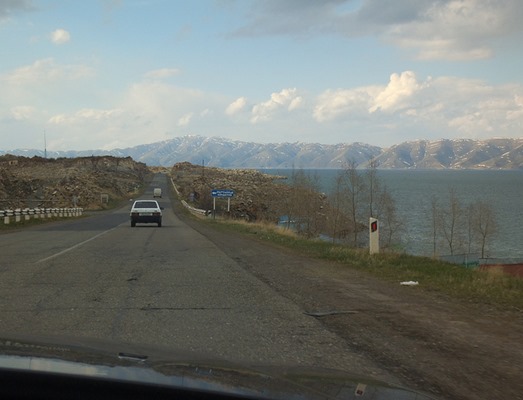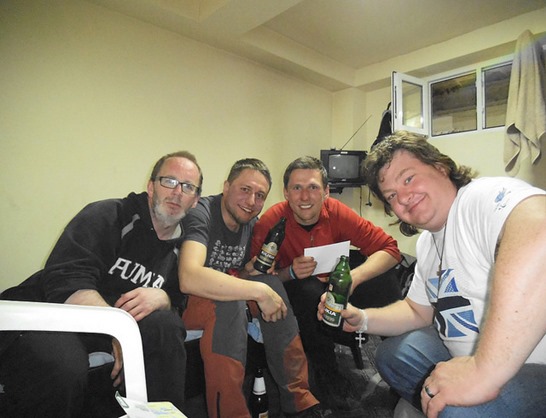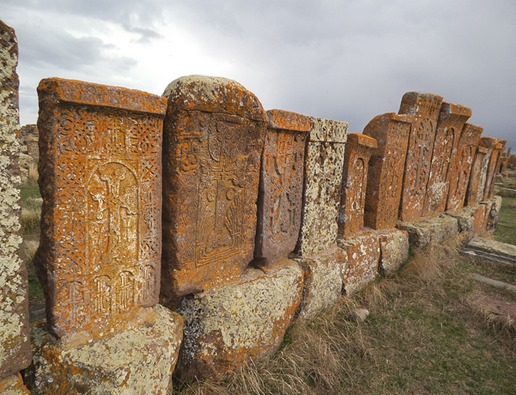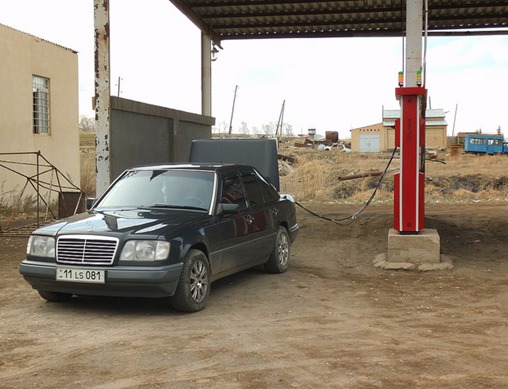Summer is here in the UK and that means one thing: cricket! I’ve just had a great evening watching T20 at Old Trafford and next Friday I’m off to the 1st Ashes Test in Cardiff.
Cricket is a strange game: those who understand it love it, those who don’t are turned off by the length of games. Yet it is an amazing cultural experience for anyone and I truly recommend catching a game in any of the countries where cricket is popular.
And so I’m off to take some of my own advice…
Keep travelling!
Uncle Travelling Matt
Links to all parts of this travelogue
Day 5: Sisian to Stepanakert and Gandazar
Postscript: A Georgian Minibreak
And also check out my 2010 trip to the lost lands of the Armenians in Eastern Turkey!
Day 8 – Lake Sevan
We arose at ten and breakfasted in the canteen café at the bus station, thinking that it would be convenient for what was to come next: catching a marshrutka for the thirty miles or so journey to Lake Sevan. However, upon finishing our victuals we found that there were no marshrutki from that bus station but instead they left from the West – or North, depending on who you asked – bus station which could be reached by catching a bus from a certain bus stop in town on Isahakian Street. There we headed only to be directed to a different stop on Terian Street only then to be directed back to the original stop. In the end we caught a taxi.
The Northern Bus Station was a good distance out of the city to the east on the Sevan road and from there it was not long before a marshrutka filled up and departed. Unfortunately, it filled up rather too much for my liking and so I saw little of the scenery going although what I did look at was very mountainous and brown. Instead though, I concentrated on reading, a lengthy, cheesy and very enjoyable historical romance named 'Shadow of the Moon' by one M. M. Kaye and for the hour or so that we were travelling I was more in 19th century British India than 21st century Armenia, falling in love with the dark-haired heroine Winter de Ballesteros almost as much as I was the raven-haired graces all about me on the marshrutka.
It was raining when we reached Sevan, the grimy little town on the shores of the famous lake, the first rain that we'd experienced since coming, so we hailed a taxi straightaway to escort us to Sevanavank, the ancient monastery on an “island” in the lake.
I write “island” rather than island because island is what everyone calls it when it is very plainly a peninsular, being very much connected to the mainland. However, the popular moniker is much deserved since, until very recently, Sevanavank was an island. Let me explain.
Lake Sevan is the smallest of the Three Great Lakes of Armenia. Like its highest mountains, the largest two of the three – Van and Urmia – are now irredeemably lost, Van in modern-day Turkey and Urmia within Iran. Indeed, I'd been to the shores of the former during my 2010 trip through the lost provinces of Armenia, an expanse of blue in a hot and arid land that melted into the horizon. That too had an Armenian city on the shore and church on an island. There though, both lay in ruins.
Despite being the smallest of the three lakes already, the Soviets earnestly desired to make it even smaller. Important figures had read the 1910 book by Armenian engineer Soukias Manasserian 'The Evaporating Billions and the Stagnation of Russian Capital' which put forward a scheme to reduce the depth of the lake from 95m to 45m, using the water for irrigation and hydro-electric power generation.[1] In addition to this, the new land created could be used for agricultural production, the idea being that the lake's “scraggy shores will be turned into sweet-smelling meadows, groves of nut-trees and oak trees... Around it beautiful roads and promenades will be laid... There could be no objection to diminishing the size of the lake for it would merely mean diminishing the annual evaporation of a vast quantity of moisture that rose uselessly into the air.”[2]
Work began in 1933 but was delayed by the war and only completed in 1949. Declared a major achievement of the Soviet Union, lake levels began to drop by one metre a year. However, after the death of Stalin and the Secret Speech criticising him in 1956, doubts about the wisdom of the project began to be raised. The trees that were meant to be growing on the reclaimed land weren't doing all that well and fish yields from the lake – which is famous for its trout – were dropping alarmingly. In 1958 a Sevan Committee was formed to try and keep the water levels as high as possible and by 1962 the level stabilised at 18m below the original. Then a 49km tunnel was built to bring 200 million cubic metres of water each year from the River Arpa into the lake (see earlier chapter). This opened in 1981 but the water levels only rose by 1.5m so a second tunnel was cut to divert 165 million cubic metres of water per annum from the River Vorotan into the Arpa and thence the lake. This 22km megaproject, (remember the mine that I discussed earlier?), was finally completed in 2008 but by this time the water levels had dropped another two metres as, after the 1988 earthquake, the collapse of the USSR, the conflict in Nagorno-Karabagh and the closure of the Metsamor Nuclear Power Station which provided Armenia with around half of its electricity, the hydro-electric plants sucking the water out of Lake Sevan had to increase their capacity in order to meet the electricity shortfall. Nowadays though, water levels are rising satisfactorily again and are expected to stabilise at 1,904m above sea level, only 11m below the original level. By 2009 a level of 1,899m had been reached, good news for everyone save those who built illegally on the newly-drained land by the lakeside.
It was still raining when we arrived on the peninsular island so we dived into a restaurant for tea and backgammon. Lake Sevan is, as I mentioned before, famous for its trout and the proprietor was eager for us to sample his, but after our hearty breakfast in the bus station, neither of us were hungry so we declained, planning to return later when we'd worked up an appetite. A rain shower, two games of backgammon and two teas a-piece later we were glad that we hadn't felt peckish for we were charged a whopping 4,000 dram for our tea, (the “complimentary” cakes were 1,000 dram each), and the Lord alone knows what the trout would have cost us. Both of us were angry but upon reflection, it was the only time we were ripped off on the entire trip so one shouldn't complain too much.
When the sky was clear we went down to the lakeside and took our photos with the fishing boats. We could have easily been at the seaside save for the fact that the water was fresh and there was a thin line of mountains on the distant horizon. It would have been extremely beautiful if it were not for the detritus of the tourist industry all around – shacks selling souvenirs and drinks, etc – so we walked away from the commercialised area around the car park and went to find somewhere a little more pristine.
 By the fishing fleet of Lake Sevan
By the fishing fleet of Lake Sevan
We didn't get very far. Only a quarter of a mile or so down the lane and we were waved back by an armed guard. The end of the island is a military zone – although what defensive purpose it serves I really struggle to comprehend – and they didn't even like us being near the fence which was a shame since the views across the placid waters were stunning. Nonetheless, I was glad to have gone that way since we passed the Soviet Writers' Guest House where the literary luminaries of the USSR once congregated to gain inspiration but which now sits crumbling and forlorn. It's a building that I'd seen on plenty of pictures, a slab of hideous 1960s modernism plonked in an ancient landscape, like putting Tracy Island from 'Thunderbirds' on Lindisfarne. As with the scheme to drain the lake that it overlooked, it spoke of an arrogant and insensitive time.
 Insensitive: The Writers’ Rest House with the monastery behind
Insensitive: The Writers’ Rest House with the monastery behind
We climbed the hill to the monastery itself though, after visiting several of Armenia's more spectacular churches, I was not expecting much, particularly as my guidebook described it disparagingly as “not really one of Armenia's most appealing places and [it] owes its popularity largely to its proximity to the lake and its accessibility from Yerevan.”[3] Yet the two tiny extant churches pleasantly surprised us both. Whilst no competition architecturally for Echmiadzin, Gandazar, Syuni or even Khor Virap, they were exquisite in their intimate, earthy humbleness and the location was breath-taking.
I went into the larger of the two churches, the Mother of God Church where I met its extremely friendly caretaker. It turned out that he was a coin collector which meant that we had something in common as I collect banknotes. He asked about British coins and after much rummaging through our pockets, Paul and I managed to locate 1p, 2p, 5p, 10p, 20p and 50p pieces which we then fitted together to demonstrate how they form the image of a complete Royal Standard. This must be quite unique in world numismatics as he was most impressed and even more so when we presented them to him as a gift. In thanks, he showed us his church's greatest treasure, an incredible 13th century khachkar which depicted – amongst other things – the Four Evangelists, the Three Kings, Adam and Eve and, most fascinating of all, Christ with His hair braided in Mongol style as it was at that time that Genghis Khan's men were sweeping through Asia destroying all in their path. It was an amazing work of art and snapshot of history and having it explained to us by such an enthusiastic gentleman made it all the more powerful to us.
I sat and prayed in the small and older Holy Apostles Church for some time. It was my favourite church in all Armenia and, perhaps significantly, also the smallest and humblest that we'd entered. Only fitting for the worship of a humble carpenter I suppose.
Afterwards I climbed the hill to its crest and sat there for some time. The 360° views over the entire lake were breath-taking and much more so because of the stark contrast with Yerevan only 30 miles or so away. There all is dusty and brown, it is warm enough to wear shorts and a T-shirt and to drink coffee outdoors after sundown. At the lake though, it was chilly even with a coat on and snow still lay on most of the slopes. The lake itself was a placid, glassy deep blue but the mountains which surround it were dark. The only place which bore any similarity to it was the landscape around Sisian and the only other area in the world that I could compare it to are the wilder, bleaker moors of Scotland, Wales and England, yet even so, there was something subtly different between here and there: it was familiar yet also very alien.
Sat on that hilltop, I made a short video reflecting on the entire trip around Armenia which was now beginning to draw to a close. There was a lot to reflect on for Armenia packs so much into such a tiny country, both human and physical. I have just discussed how radically different the landscapes around Lake Sevan and Sisian are to Yerevan yet they were only two of several that we'd witnessed on our journeyings. The incredibly brown Debed Valley on the way in that was almost Albanian; the peaks and valleys of Nagorno-Karabagh that could have been in the Carpathians of the mountains of Bosnia and then that flat, fertile plain on which stood the ruins of Aghdam, almost Dutch from a distance.
But the physical geography was only half of it and, although I know this sounds like a cheesy cliché, it is her people that make Armenia so special. Their native art style is truly unique, at times Persian, at times almost Islamic, then somehow Celtic yet always wholly Armenian; the national church which is instantly recognisable and both independent and different from any other church on the planet, and then the great city of Yerevan which must rate as one of the most cultured and civilised capitals on the planet. And once you've finished looking at all that then there's the women, oh the women...
As I sat there I noticed two lovers in embrace lower down the slope, oblivious to the world as they gazed into one another's eyes, their forms silhouetted against the glittering waters of the lake. It was a beautiful and timeless image and an honour to be able to witness it. I just hope that they don't mind that I captured them for all eternity with my camera.
We ummed and arred over what to do once we had descended the hill. We'd seen what we had come to see but it was still early. Around fifteen miles down the shore of the lake lay the Field of Khachkars, the finest collection of cross stones in all Armenia with just under a thousand dating from all era of Armenian history. The guidebook raved about it, calling it a highlight of the land, but we had seen a hell of a lot of khachkars already and wondered what seeing a load more would give us. In the end though, after some debate, the lack of alternatives made us decide to get a taxi out to them, agreeing a price of 6,000 dram for the trip.
The drive along the water's edge was fascinating and as we rode realised just how far reality had proved to be from the Soviet vision of “sweet-smelling meadows, groves of nut trees and oak trees” with “beautiful roads and promenades”. The whole scene was instead bleak, not helped by the spitting rain and melting snow I admit, but nonetheless, the road was bumpy rather than beautiful, the land by the shore bare or dotted with straggly bushes and the buildings dilapidated. The scene reminded me more of Kazakhstan or some other Central Asia republic than a lakeside paradise.
 Not quite paradise: Driving by Lake Sevan
Not quite paradise: Driving by Lake Sevan
We passed by the town of Gazar, formerly Nor Bayazit – New Bayazit – where the refugees from that now Turkish – or to be more ethnically accurate, Kurdishj – city fled to. I'd stayed in their old home four years before and seen the ruins of the Armenian town although, ironically, the whole city had now been relocated a mile or so to the west and the new settlement is now named Doğubayazıt which translates as, you've guessed it, New Bayazit.
The Field of Khachkars, an immense cemetery near to the lake's edge, reminded me of an ancient churchyard in North or Mid Wales somewhere, but that may just have been because of the drizzle. It was a remarkable place and we spent a good half an hour there wandering amongst the khachkars and photographing some of the more interesting ones, but our earlier fears were realised and there are only so many carved stones that a man can truly appreciate and we had already reached our limit.
On the way back our driver stopped to fill-up with gas and afterwards I took the opportunity to solve the gas rather than petrol mystery. The answer was simple: in Armenia petrol sells at 500 dram per litre whilst gas is 250 dram. Most of that gas comes from Russia, (and a little from Iran), whom Armenia is friendly with unlike its northern neighbour Georgia. But how did this gas get through considering the Turkish and Azerbaijani blockades to the west and east and Georgia being in the way to the north. “Bribes sort that out,” was the explanation given. This prompted a then and now conversation and our driver, a man in his forties, was adamant that things were better when Armenia had been a part of the USSR. People had jobs and money then; now the roads are awful. Gorbachev, in his opinion, “fucked everyone up the arse”.
In Sevan, perhaps the grottiest town in all Armenia, the roads were truly awful, the main streets being more like a farm track. And to make it worse, when we got there, the last marshrutka back to the capital had already left. We negotiated a price of 7,000 dram with our driver and headed back by car which was much pleasanter than the journey going as we were now able to see the scenery as we dropped around a thousand metres back down to the plain. As he drove our driver continued with the corruption theme, talking about hotels owned by the president's brother and pointing out a gangster's mansion on the edge of the city that was built to look like a church and was where Dmitri Medvedyev had stayed a year or two before.
In the capital we met up with the boys that we'd got acquainted with before our jaunt down to Nagorno-Karabagh. They arrived with friends and all were football-mad – good for me but less so for Paul who, as a Munster man, prefers the other shaped ball. There was Aram who supported Manchester United, Alfred an AC Milan aficionado and David who liked Arsenal. We walked around the streets, talked largely of the beautiful game but also of the boring architecture on the new Northern Avenue,[4] with lashings of macho gesturing and a sad, yet predictable, burst of homophobia which is de rigeur in that area of the world. We showed them the David Moyes graffiti which Alfred and David found funny, Aram less so, and then we retired to a sports bar to watch the semi-final of the German domestic cup between Borussia Dortmund and Wolfsburg. This was a popular game amongst the locals since Armenia's star striker, their best player for a generation or more, Henrikh Mkhitaryan, was playing up front for Dortmund and the bar was offering a 15% discount on all drinks if he scored. Anyway, the boys proved to be excellent company and we had a good night indeed, particularly when Mkhitaryan did score and the whole place erupted in cash-saving jubilation.
 Drinks with the footie mad lads
Drinks with the footie mad lads
When we got back to our hotel we found two other travellers had checked-in next door. They were the first other backpackers that we'd seen all trip and we soon fell into conversation. Filip and Vilem were a pair of Czechs with a passion for mountaineering and another for alcohol. They'd just arrived from Georgia where they'd tried – and failed – to climb Mt. Kazbek and met a couple of “fun” Ukrainian girls on the bus. They were good company and so we talked and drank into the small hours although when Paul went to the toilet, Filip asked as to why he had no trouble understanding my English but struggled with that of my friend. “You know how a Slovak speaks Czech,” I replied and they nodded in understanding.
 And more drinks with the Czechs in our dungeon
And more drinks with the Czechs in our dungeon
[1] Manasserian also produced the plan to drain the Aral Sea which has left fishing boats stranded in a salty desert and has become an ecological disaster of immense proportions. They probably have a dartboard with his face on it at Greenpeace headquarters.
[2] Soviet propaganda quoted in Armenia with Nagorno-Karabagh, p.173.
[3] Armenia with Nagorno-Karabagh, p.175
[4] The Northern Avenue was part of Tamanian's original master plan that was never constructed. In 2002 work controversially started to complete the great man's vision and it is now open to the public, a broad new boulevard linking Republic Square with the Opera House. However, it has attracted much criticism due to the standard of its buildings being far below the quality of those built by Tamanian and the corners cut during construction.








No comments:
Post a Comment